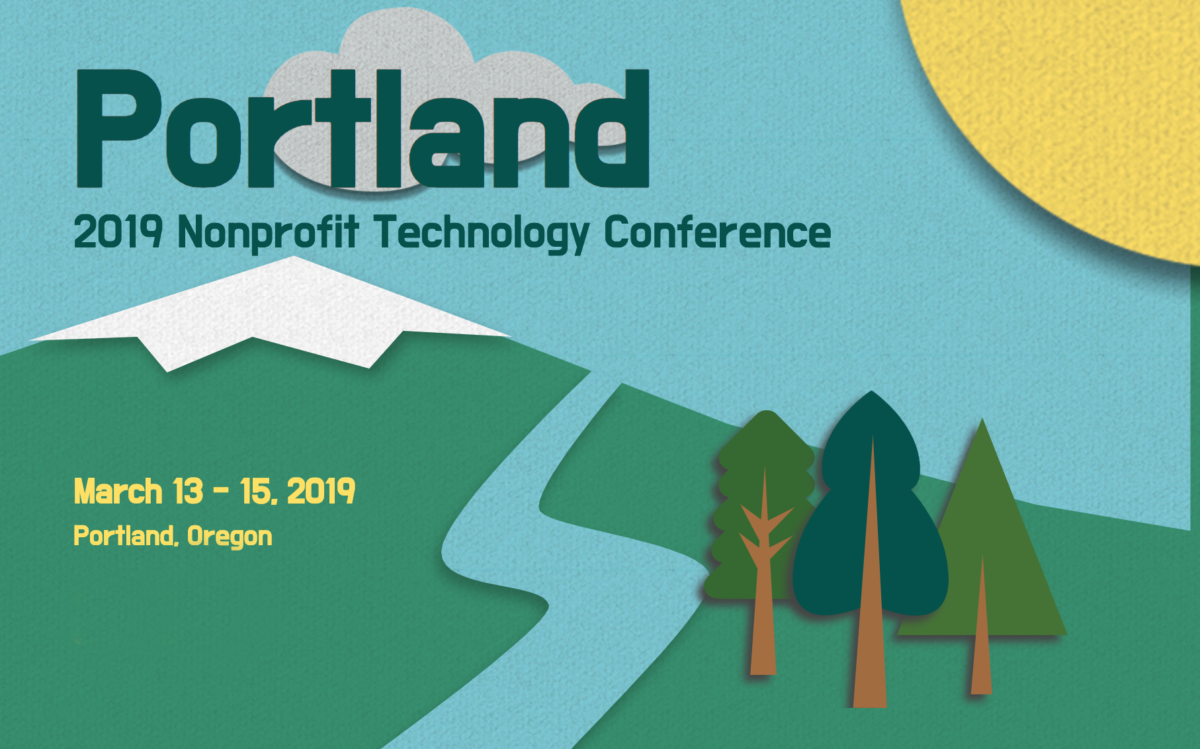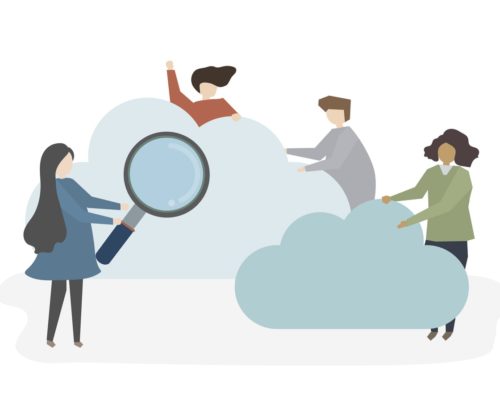The 2019 Nonprofit Technology Conference, hosted last week by the Nonprofit Technology Network (NTEN), was a whirlwind three days. Leaders from across the nonprofit sector came together to share their insights and help others leverage technology to fulfill their missions.
Nearly everyone was talking about how online giving experienced a major slowdown in 2018. But, as nonprofits do when faced with a challenge, everyone arrived ready to share success stories and find solutions together.
The conference was jam-packed with Aha! moments and best practices that we wished we knew when we were just getting started with fundraising. To make sure you get the most out of your online fundraising efforts this year, we’re sharing highlights from the sessions we attended to help you:
- Retain your donors and grow your monthly giving program
- Run an effective social media campaign on $100 a month
- Discover some of the best free tech tools out there for nonprofits
In each of the following sections, you’ll also find links to the presentations (where available) and collaborative session notes.
Retaining Your Donors and Growing Your Monthly Giving Program
New donors are the most difficult to retain. BUT they are also the most likely to become recurring donors!
Focus on converting brand new donors. The moment someone makes a donation to your organization is when they’re most excited about your cause. Don’t let this enthusiasm fall by the wayside. Give timely thanks and swiftly encourage them to become a sustaining (monthly) donor.
You should be sending an automated welcome series to new donors.
This takeaway inspired major FOMO (fear of missing out) when we heard about it. We know that we should send thank-yous, but a welcome series helps you take your fundraising to the next level. Write these emails in advance and have them scheduled to send as soon as someone makes a donation. The organizations at the conference sent a series of 3, 5 or 7 emails to welcome new donors and encourage recurring giving. The first email goes out right away, and the rest are paced out over the course of a week or two (with roughly three days between each send).
Our tip: use Mailchimp to automate your welcome emails. Their tools are well documented and free to use, depending on this size of your mailing list.
Clean data is key for donor retention.
The fastest way to lose a donor is to accidentally call them “Bob” instead of Barbara. Or to forget to mention that they’re already a sustaining donor. Make sure to track your donor data across all your systems (names, contribution amounts and dates, and any other information related to their engagement with your organization) and use that data to personalize your communications.
For more on data hygiene, check out Clean Up Your Act: Donor Data Management for Nonprofits.
Segment your existing donor outreach to encourage recurring donations.
Donors who give consistently are primed to become monthly donors. Segment your outreach to active donors (for example, donors who have given between $25-$99 and made 2+ gifts) and ask them to make a monthly contribution.
Other tips:
- With limited resources, focus on well-written content to highlight your mission and skip designing fancy visuals.
- Keep donors giving: always talk to sustaining donors like they’re sustaining donors. Never ask them to “join” when they’re already involved!
- Send something that’s not an ask. Repurpose your blog content and send a segmented email to monthly donors. Use the frame of “what you’ve made possible as a monthly donor.” Or send a holiday card, no ask included.
Learn more:
Finders, Keepers: The Art of Donor Retention
Presented by Paul Habig & Laura Cole of Sanky Communications and David Onate from the African Wildlife Foundation.
Check out collaborative notes from the session.
MAKE it Monthly: Growing and Retaining Your Monthly Donor Pool
Presented by Jack Hilson & Nick Garcia from Mal Warwick Donordigital and Josh VanDavier from KQED Public Media.
Check out collaborative notes from the session.
Effective Social Media Advertising on $100 a Month
For nonprofits, Facebook isn’t a social media platform. It’s an ad platform.
Organic post reach just isn’t what it used to be. As an organization on Facebook, you’re reaching less than 5% of your audience with unpaid posts. And if anyone at your organization is spending time posting on Facebook, you’re already investing in the platform.
Don’t pay to boost your posts on Facebook.
This is different from running Facebook ads! You can click the “Boost Post” button on any of your posts to have it shown to more people, but it’s not worth the cost. (In this session, they joked that all this really does is help Mark Zuckerberg buy another hoodie.) Instead, use targeted Facebook ads to drive the type of engagement you want to see.
Consider the “commitment curve” when creating ads on Facebook.
View > Like > Share > Signup > Contribute > Invite > Donate $$ > Attend an Event.
From left to right, the above actions become increasingly more expensive (in terms of both time and money) to achieve through Facebook ads. Low-barrier actions are less expensive, but also have a lower ROI, such as viewing a video, sharing a post, etc. Medium-barrier actions include signing up for your email list or signing a petition. The highest barrier actions are most expensive to achieve through digital ads, like getting viewers to become donors or attend events. Before you spend any money on social advertising, decide what you’re willing to invest to achieve your desired result. Then measure and refine your strategy as you go!
Set your Facebook ad objective carefully.
When you’re creating an ad on Facebook, the first step is setting an objective. Avoid any of the “Awareness” objectives on the left-hand side. The related metrics are vague and it’s hard to translate them into something meaningful for your organization. Instead, select from “Traffic,” “Video Views,” “Lead Generation” (email captures), or “Conversions.” Any objective you set should be directly linked to a marketing goal.
Know your audience and serve ads at the right time.
If you’re trying to recruit teachers, don’t serve ads during the day while they’re at work! If you’re working with young people and want them to engage on your website, they probably will be doing other things on the weekend. Setting the time of day that your ads get displayed will help you spend money more effectively.
Other tips:
- Consider YouTube display ads. YouTube is the second largest search engine out there. Don’t overlook this effective channel!
- If you’re just getting started, check out our post on Facebook Ads for Nonprofits.
Learn more:
Effective Social Media Advertising on $100 a Month
Presented by Alison Glazer from Whole Whale and George Weiner from Whole Whale/PowerPoetry.org.
Check out collaborative notes from the session.
Some of the Best Free Tech Tools for Nonprofits
This 30-minute session was packed full of the most amazing free tech tools out there to help you get your job done. Below is a selection of our favorite ones, but you should definitely check out the collaborative notes for the full list!
1. BITWARDEN or 1PASSWORD
These password managers help you keep your nonprofit safe online—and they’re (reputable and) free! All you’ll need to remember is one password for login.
2. VIDYARD – GOVIDEO
This chrome extension lets you capture video right from your computer and share it via link. It’s great for simple, personalized thank-you videos for donors on the fly! Your staff can record a quick message and add the link right into your thank-you email.
3. PHOTOPEA
A free online version of Adobe Photoshop. It’s great for when you have limited licenses in the office and need to make edits to photos (without borrowing someone’s laptop).
4. REMOVEBG
Have you ever tried to manually remove a background from a photo? You need to know Adobe Photoshop and it still takes forever. This tool lets you remove the background in a few clicks, as long as the photo is of people. The technology relies on facial recognition, so it’s not great at removing backgrounds from other images. But still, it’s a huge time-saver!
5. TEMI.COM and REV.COM
These tools are so helpful for transcribing speech to text or captioning your videos. While they’re not free, the rates are as low as $0.10/minute for transcription or $1.00/minute for captions.
6. MEEKAN by Doodle
Forget sending out Doodle polls and waiting for responses or going through everyone’s calendar manually to schedule a meeting. Meekan’s AI will analyze schedules and automatically find a meeting time that works for everyone.
7. KRISP.AI
If you ever need to join a conference call from a crowded coffee shop, this AI driven audio filter will remove the background noise so all they hear is your voice.
8. TWILIO
Jason Shim, the session presenter, demonstrated this tool in real-time. With Twilio, you can automate a series of text messages to collect information from potential volunteers or other event attendees. Just setup your custom messages in advance and have everyone text a single phone number to participate from their phone. A great resource that lets you ditch the clipboard and manual entry for followup!
9. STAYRESPONSIVE.COM
Want to know what your donation form looks like on mobile? (You should.) You can enter your URL and preview what your content looks like to make sure that it renders properly for everyone, regardless of the device they’re using.
10. JUSTGETFLUX.COM
This last tool is about self-care. If you’re having trouble falling asleep at night, it might be from staring at your computer screen all day. Installing f:lux filters out the blue light that comes from our screens and messes with our sleep patterns.
Learn more:
A Tool Extravaganza: New Tactics to Use Now
Presented by Jason Shim, NTEN Board Member and Director of Digital Strategies at Pathways to Education Canada.
Check out the collaborative notes from the session.
We’re still combing through our notes and processing everything we learned. But we’re already excited about next year’s conference, which will be March 24-26th in Baltimore, MD.




